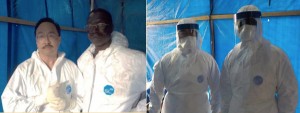A Fil-Am scientist’s Ebola warning for PH
Filipino-American scientist Jorge Emmanuel didn’t exactly have a pleasant holiday break last month. He spent that time isolated, unable to celebrate with family and friends.
The reason: Ebola.
He had just returned from Africa on a mission related to the dreaded virus and had to be quarantined.
That ended a few weeks ago when Jorge left for Manila to continue his Ebola work. Today, Jan. 28, he is speaking on the epidemic, specifically, on the dangers posed by the fight against it.
For that was why he was in Africa.
Jorge is an environmental scientist and the United Nations asked him to look into one critical area of the anti-Ebola campaign: how best to dispose of medical and other waste from efforts to end the epidemic.
Article continues after this advertisementEbola, which is known to have wiped out entire villages in parts of Africa, remains a serious concern. But Jorge has another warning for the Philippines: the fight against the virus could turn into an environmental nightmare.
Article continues after this advertisementJorge is a recognized expert on the safe and environmentally sound disposal of hazardous waste. We worked together more than 20 years on an investigation of the environmental damage caused by the US military at Subic and Clark where Jorge led a team of scientists inspecting garbage dumps, firing ranges and even rivers and streams.
(Their findings were featured in “Toxic Sunset,” the 1993 documentary I co-produced with filmmaker Louella Lasola.)
Jorge was invited to visit Africa to help doctors, health professionals and public officials find safer ways to handle and dispose of medical waste.
“Medical waste is a serious problem,” he told me. “If not treated and only dumped especially in developing countries, it could lead to the spread of infections.”
One practice has been a major concern: incineration. Burning medical waste causes pollution and the release of carcinogenic materials, Jorge said.
The practice led to guidelines aimed at curbing the pollution and other harm caused by incineration, guidelines so strict they essentially led to a ban in many countries, including the Philippines.
But fear of Ebola has led to calls for a return of incinerators.
Jorge visited Manila partly to help NGOs explain the dangers posed by proposals, highlighted by a pending bill, to lift the ban on incinerators in the Philippines.
“They’re using Ebola to bring back incinerators,” Jorge said. “My message is, ‘We’re working in Africa to do the opposite.’”
In the African communities he visited, he added, “people were trying to fight the disease and they have to breathe all these toxic fumes.”
Jorge has troubling memories of the fight against Ebola in Africa.
One incident he will likely never forget. One afternoon, health personnel in Sierra Leone began bringing out bodies of victims. Waiting outside was a woman. Among those who had just died was her son.
“The mother wanted to touch the body bag, but she was stopped by a member of the community,” he recalled. “When they told her she couldn’t come close, she just collapsed.”
“It was devastating. … That sad day, it really got to me. It was the first time bodies were brought out. By the time they were brought out, all you see are the white body bags. That’s why it was so heart-wrenching for the families. It was really devastating.”
Visit the Kuwento page on Facebook at www.facebook.com/boyingpimentel
On Twitter @boyingpimentel
(Jorge Emmanuel will speak at a forum on Ebola epidemic at the Cocoon Boutique Hotel in Quezon City sponsored by Health Care Without Harm Asia and the UP College of Public Health.)
